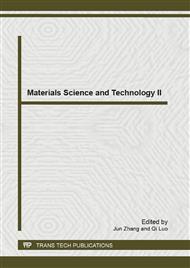[1]
A.Celzard, J.F. Marêché and G. Furdin. Modelling of exfoliated graphite. Progress in Materials Science Vol. 50(2005), pp.93-179
DOI: 10.1016/j.pmatsci.2004.01.001
Google Scholar
[2]
D.D.L. Chung. Electromagnetic interference shielding effectiveness of carbon materials. Carbon Vol.39( 2001), pp.279-285
DOI: 10.1016/s0008-6223(00)00184-6
Google Scholar
[3]
XING Xiao-ling, HUANG Yu-an, HUANG Run-sheng et al. Preparation,characterization,and electromagnetic shielding effectiveness of the composites of nano-particles of Co dispersed on expanded graphite. Journal of Nanjing University(Natural Sciences) Vol.45(2009), pp.570-575
Google Scholar
[4]
LIU Lan-Xiang, HUANG Yu-An, HUANG Run-Sheng et al. Preparation and Characterization of the Nano-particles Composites of Ni-Fe Alloys Dispersed on Expanded Graphite for the Shielding of Electromagnetic Radiations. Chinese Journal of Inorganic Chemistry, Vol.23 (2007),pp.1667-1670
Google Scholar
[5]
REN Qiang-Fua, JIA Ying, ZHANG Qiu-Yu. Property of Electroless Nickel Plating on Expanded Graphite. Chinese Journal of Applied Chemistry Vol.26(2009), pp.495-497
Google Scholar
[6]
WEI Lai1, HUANG Yu-an, ZHANG Ji-qiao et al. Preparation of Ni-P/expanded graphite composite for electromagnetic shielding. Journal of Magnetic Materials and Devices Vol.42 (2011), pp.32-36
Google Scholar
[7]
J1A Ying, REN Qiang-fu, LI Zhi-peng et al. Microwave Absorbance Behavior of Expanded Graphite-Based Composite Electroless Plated with Metallic and Alloy Coatings. Materials Protection, Vol.42(2009), pp.21-26
Google Scholar
[8]
ZHANG Yan-Qing, SUN Qing-Rong. Influence Factors of Magnetic Exfoliated Graphite Prepared by Citrate Sol-Gel Process . Journal of Inorganic Materials Vol.23 (2008), pp.794-798
DOI: 10.3724/sp.j.1077.2008.00794
Google Scholar
[9]
ZHANG Qian, JIAO Qing-jie, GUAN Xiao-cun. Preparation and electromagnetic properties of nano γ-Fe2O3/expanded graphite composite material [J]. Transactions of Materials and Heat Treatment Vol.31 (2010), pp.30-33
Google Scholar
[10]
PENG Jun-fang, KANG Fei-yu, HUANG Zheng-hong. Materials Science and Engineering Vol.20( 2002), pp.469-472
Google Scholar
[11]
ZHOU Ming-Shan, LI Cheng-Jun, XU Ming et al. Electromagnetism Characteristics and 3mm, 8mm Wave Dynamic Attenuation Performance of Expanded Graphite Composite. Journal of Inorganic Materials Vol.22( 2007), pp.509-513
Google Scholar
[12]
Iijima S. Helical microtubules of graphitic carbon. Nature( 1991), P.354:56-58
DOI: 10.1038/354056a0
Google Scholar
[13]
PENG Zhi-hua. Investigation on the Microwave Absorbing Mechanisms of the Materials Containing Carbon Nanotubes. Changsha: Doctoral dissertation of HuNan University. 2010.
Google Scholar
[14]
SUN Kang-ning, LI Ai-min. Cabon-nanotube-basede composites. China Machine Press. (2010)
Google Scholar
[15]
Zhou Liang, Liu Jiping, Li Xiaohe. Purification of Carbon Nanotubes. Chemistry, Vol2(2004), pp.96-102
Google Scholar
[16]
Zhu Ya-Bo, Bao Zhen, Cai Cun-Jin et al. Study on the thermal stability of carbon nanotubes by simulation. Acta Physica Sinica Vol.58(2009), pp.7833-7837
DOI: 10.7498/aps.58.7833
Google Scholar
[17]
WangS, LiangR, WangB, et al. Dispersion and thermal conductivity of carbon nanotube composites . Carbon Vol47(2009),pp.53-57
Google Scholar
[18]
A jayan PM , Ebbesen T W, et al. Opening carbon nanotubes with oxygen and implications for filling . N ature Vol362(1993),pp.523-525.
Google Scholar
[19]
CHENG Hui-ming. Preparation/structure/physical characteristics and its aplication. Beijing: Chemical Industry Press. (2002)
Google Scholar


